Fire
Bombing of Tokyo
Click
on picture and drag top right dot to enlarge to where it can be read. It
will take several drags to return picture to original size. Text below is
explanatory.
Different presentations such as downloaded to computer, CD or internet will
require differing methods of enlarging and viewing. Play with it.
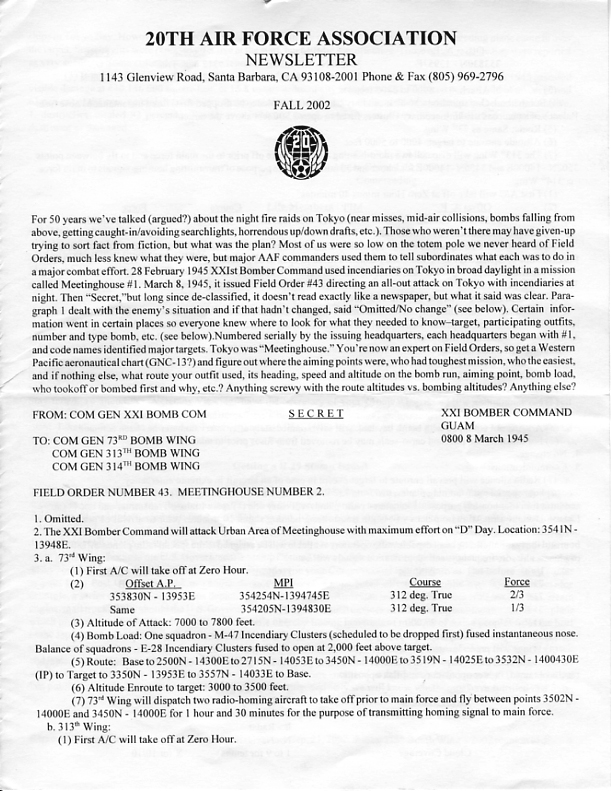 The
Offset Aiming Point (AP) that allowed certain pathfinder B-29s equipped with
APQ-23 radar equipment to put in the distance and azimuth from a radar visible
point and a target point into the radar computer. This was the
great-granddaddy of RNAV that allows VORs and airways to be electronically
offset to provide better traffic separation between aircraft.
MPI means mean point of impact. (Average distance from intended impact point.)
The
Offset Aiming Point (AP) that allowed certain pathfinder B-29s equipped with
APQ-23 radar equipment to put in the distance and azimuth from a radar visible
point and a target point into the radar computer. This was the
great-granddaddy of RNAV that allows VORs and airways to be electronically
offset to provide better traffic separation between aircraft.
MPI means mean point of impact. (Average distance from intended impact point.)
During WWII the MPI of radar bombardment was three miles. The MPI of
all the bombs dropped in WWII was close to five miles. Today the MPI is
ten-feet or less.
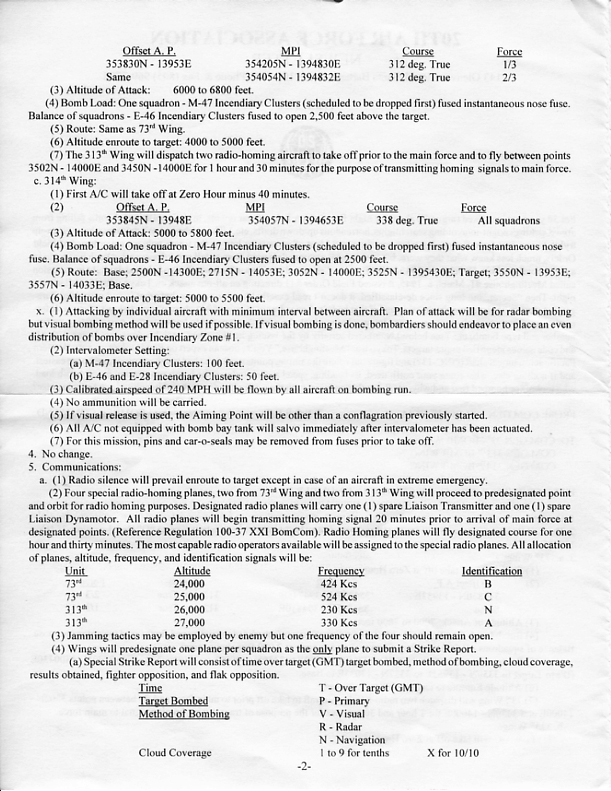 The
intervalometer was a bomb release device that spaced the release of the bombs so
as to increase the spread of the fire.
The
intervalometer was a bomb release device that spaced the release of the bombs so
as to increase the spread of the fire.
Look at #4 No ammunition will be carried. This was a very very carefully
considered order by Le May Who evaluated the benefit/risk factors and
proceeded according to plan. The night fighting capability of the Japanese
was minimal. The altitudes selected were above the smaller caliber
antiaircraft weapons and below the most effective ranges of the higher powered
weapons. Once overseas the 20mm cannon used as a tail gun was
immediately removed since it was not worth its weight.
The weight savings increased the effective bomb load and fuel safety
margins. Flying and bombing at lower altitudes greatly improved the
circular error factors (MPI) often involved in previous drops from the 20/30 thousands
of feet.
Not flying in formation reduced flight stress, fuel consumption and the
homing beacon aircraft would improve ease of navigation. Le May decided the
reduction in risks and improvement in bomb load and accuracy were worth
it. The crews were unhappy with the risks but essentially obeyed and flew
as ordered. There were exceptions.
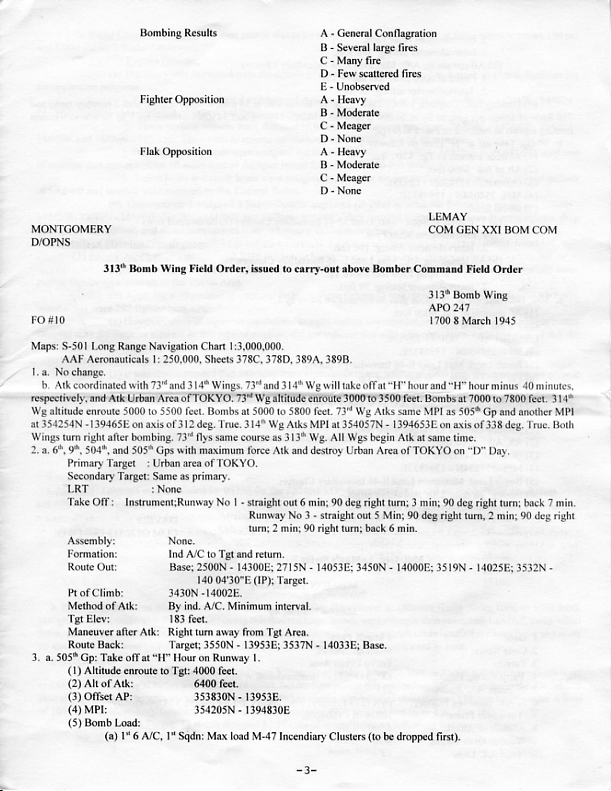 A
little known aspect it the B-29 bombing procedure was the turns required prior
to the straight line used to the target and the turn after "bombs
away". The usual speed during the bombing procedure was 210 miles per
hour. If the standard rate turns were used at both ends of the procedure
it means that the needle of the turn and bank indicator would be under the 'dog
house' giving a three degrees per second turn.
A
little known aspect it the B-29 bombing procedure was the turns required prior
to the straight line used to the target and the turn after "bombs
away". The usual speed during the bombing procedure was 210 miles per
hour. If the standard rate turns were used at both ends of the procedure
it means that the needle of the turn and bank indicator would be under the 'dog
house' giving a three degrees per second turn.
The actual process of plotting this turn at the intersection of two straight
lines would require determining the radius of the turn based on aircraft
speed. It didn't take navigators long to discover a short-cut. All
you had to do was to draw the straight lines of each side of the turn and place
a Lincoln-head penny in the corner so as the arc of the penny's circumference
would provide a smooth transition from entry to departure of the turn.
You can do this yourself just by drawing two intersecting lines and put a
penny where it gives a smooth arc between the two lines. The arc entry is
the beginning of the required turn and the arc exit is resumption of level
flight. Good enough for government work.
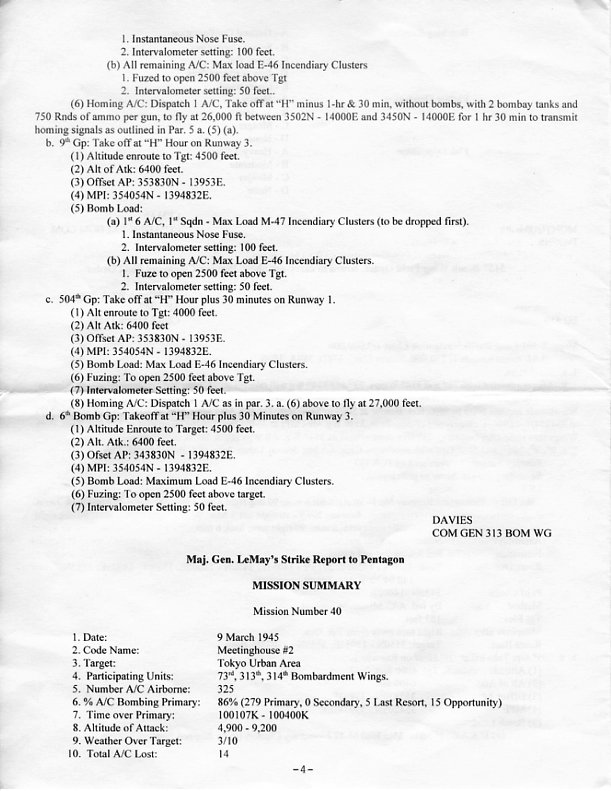 l
l
This
particular mission was the beginning of a large series of missions devoted to
the use of incendiary bombs. It soon became apparent that some bombs were
more effective than others. In the next five months of the war critical
shortages in preferred bombs resulted in the use of less effective bombs and
less effective results.
At the same time of the fire bombing emphasis by most of the B-29s there were
two significant programs in progress that are seldom mentioned. There were
B-29s who dropped mines that had different kinds of activation. Some mines
would count ships before exploding. Some would become active only after a
period of time. This mining was also a part of other types of aircraft
both army and navy. By the end of the war japan had only four aircraft
carriers while the U.S. Navy had close to a hundred.
Another B-29 group was equipped with the APN-7 'Eagle. This a a
precision bombing radar that specialized in bombing refineries and oil
distribution facilities. Japan never developed the synthetic oil
production as had Germany. Many naval missions by the Japanese carried
only enough fuel for a one-way trip.
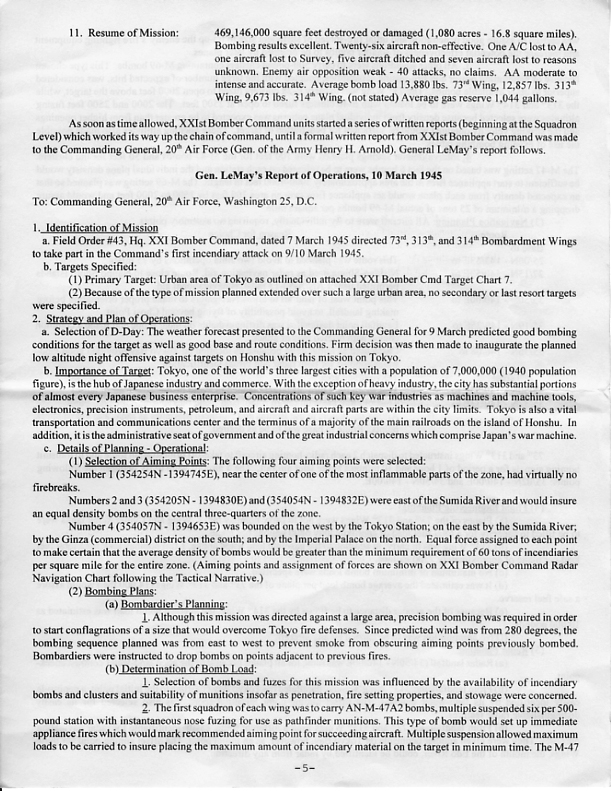 The
bomb selection began with use of bombs that would serve as markers or aiming
points for planes following. The very best crews served as 'pathfinders'
and their bombs often had colored explosives. Each aircraft bombed individually with as
much precision as possible to ignite the areas at the edges of existing fire.
The
bomb selection began with use of bombs that would serve as markers or aiming
points for planes following. The very best crews served as 'pathfinders'
and their bombs often had colored explosives. Each aircraft bombed individually with as
much precision as possible to ignite the areas at the edges of existing fire.
The direction of the attack is based on forecast winds, geography of the area
as divided by terrain and bodies of water.
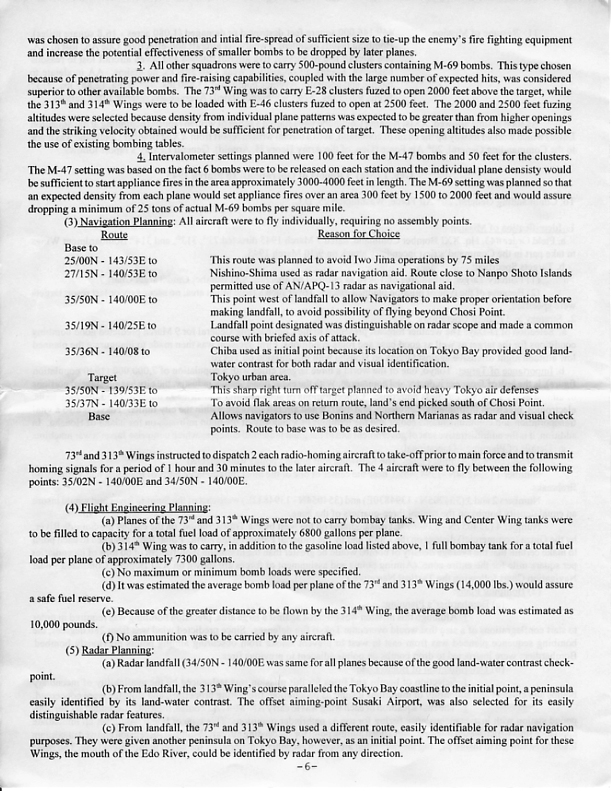 Since
Iwo Jima was still Japanese with three airfields at this time, the area had to be
avoided as much as practical. P-51 fighters were coming more available
with capability to interdict Japanese aircraft on Iwo as well as on the home
islands of Japan. The 1400 mile flight from the Marianas to Japan and
return required that fuel calculations for adequate reserves be as conservative
as possible. The more fuel carried caused a reduction in bomb load.
Since
Iwo Jima was still Japanese with three airfields at this time, the area had to be
avoided as much as practical. P-51 fighters were coming more available
with capability to interdict Japanese aircraft on Iwo as well as on the home
islands of Japan. The 1400 mile flight from the Marianas to Japan and
return required that fuel calculations for adequate reserves be as conservative
as possible. The more fuel carried caused a reduction in bomb load.
The loss of a certain percentage of aircraft was a given for every
mission. The plan was to keep the loss ratio at a level to permit a
sustainable campaign. I have figured my bomb groups losses in known combat
and anti-aircraft losses at five-percent. Greatest area of loss was called
'operational' This is a mix of weather, mechanical failure, pilot error
and unknown took about thirty percent of the aircraft over a three year
period. The loss of an aircraft was not necessarily a total loss of the
eleven man crew. Nearly 70 percent of the 129 aircraft assigned
to my 468th Bomb group survived the war.
In the beginning of its combat life the B-29 had several teething problems.
The B-29 was the most complex aircraft of its time. It had more
wiring, pressurization, electronics, weapon and engine problems than any
previous aircraft. It had gun turrets that were remotely aimed and
controlled by different gunners as targets presented themselves.
The wiring problems usually had to do with the plug connections into
electrical boxes. Vibration, corrosion and moisture were always sources of
difficulty. A common maintenance solution for plug problems was to kick
the problem box. The higher altitudes of B-29 operation caused arcing of
connections and failure of radio tubes.
Pressurization areas existed in the front and back of the bomb bays as well
as for the tail gunner. A 20-inch crawl tube existed over the top of the
bomb bay to allow some movement between areas. A 6x9 tube went to the tail
gunner. Pressurization greatly added to the en route comfort of the crews.
Loss of pressure due to a plexi-glass window blowing out was an always present
hazard.
B-29s had more electronics that any previous aircraft. The fire control
system for the machine guns was armor plated. It allowed the gunners to
move their sights and thereby move the turret and guns. You set the sight
primarily by knowing the wing span of the aircraft you were shooting at.
All factors involved beyond that was done by computer. A very primitive computer
by today's standard.
The engines of the B-29 were designed ahead of their time and pilots and
engineers had to play catch up. Cooling flaps were large. Pilots had
to learn that wide open engine flaps were not as efficient as partially open
flaps flown at higher speeds. I believe the B-29 had the first engine with
hollow sodium filled exhaust valves to improve cooling.
For the better part of a year the average B-29 in India was lucky to get 50
hours on an engine before needing a change. Taking off from India and
climbing most of the 600 miles to China was very hard on the engines. By
the end of the war the average was approaching 800 hours.
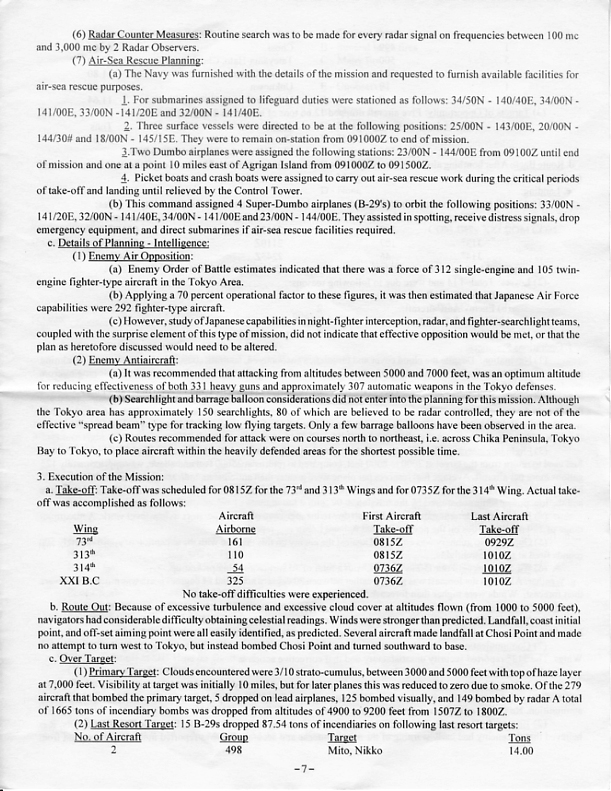 About
one aircraft per squadron would carry Radar Counter Measures equipment and an officer
specialist who would search and detect frequencies that could be jammed
electronically or by dropping aluminum foil strips called chaff or window
depending on length. These strips tended to produce multiple targets to
confuse Japanese radar controlled antiaircraft guns.
About
one aircraft per squadron would carry Radar Counter Measures equipment and an officer
specialist who would search and detect frequencies that could be jammed
electronically or by dropping aluminum foil strips called chaff or window
depending on length. These strips tended to produce multiple targets to
confuse Japanese radar controlled antiaircraft guns.
Prior to the capture of Iwo Jima numerous surface ships, submarines and Dumbo
aircraft stationed along the arrival and departure routes in case an damaged aircraft had
to ditch into the ocean. Dumbo aircraft could carry and drop a rescue boat
or raft. The taking of Iwo saved over 25,000 Air Force lives. One of
my 468th Bomb Group B-29s was the first to make an emergency landing on Iwo.
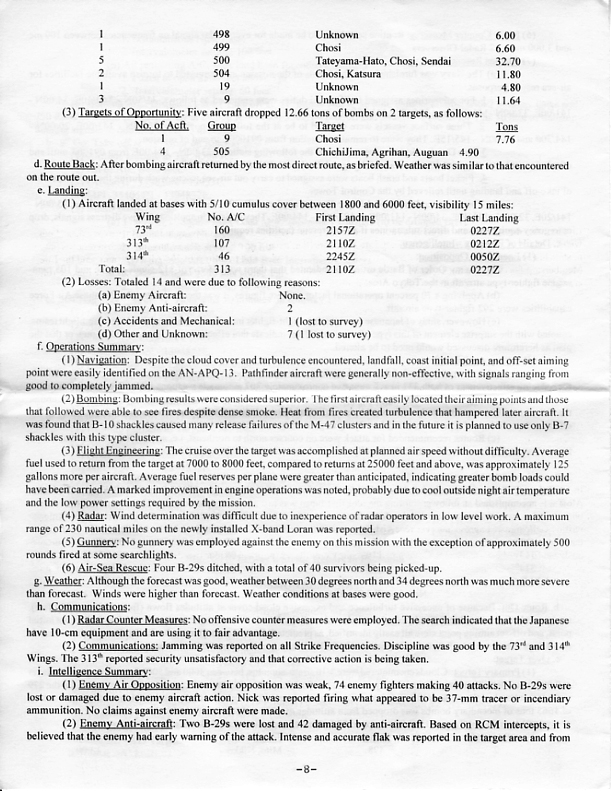 The
end of this page presents a summary of the mission. Prior to the capture of the
Marianas of Guam, Saipan and Tinian B-29s were attacking Japan on an average of
every three weeks via China. By April the 20th Air Force was able to
attack with over 300 B-29s out of the Marianas. Three months later there
were over 500 and by 1946 the available bombers would have numbered 2000.
The
end of this page presents a summary of the mission. Prior to the capture of the
Marianas of Guam, Saipan and Tinian B-29s were attacking Japan on an average of
every three weeks via China. By April the 20th Air Force was able to
attack with over 300 B-29s out of the Marianas. Three months later there
were over 500 and by 1946 the available bombers would have numbered 2000.
As the end of the war the B-29s were destroying an average of over 70-percent
of a large Japanese city daily.
At various times near the end of the war we were running out of the type of
bombs we found most effective. At the end of the war we had used all the
atomic bombs (two) available in the Pacific.
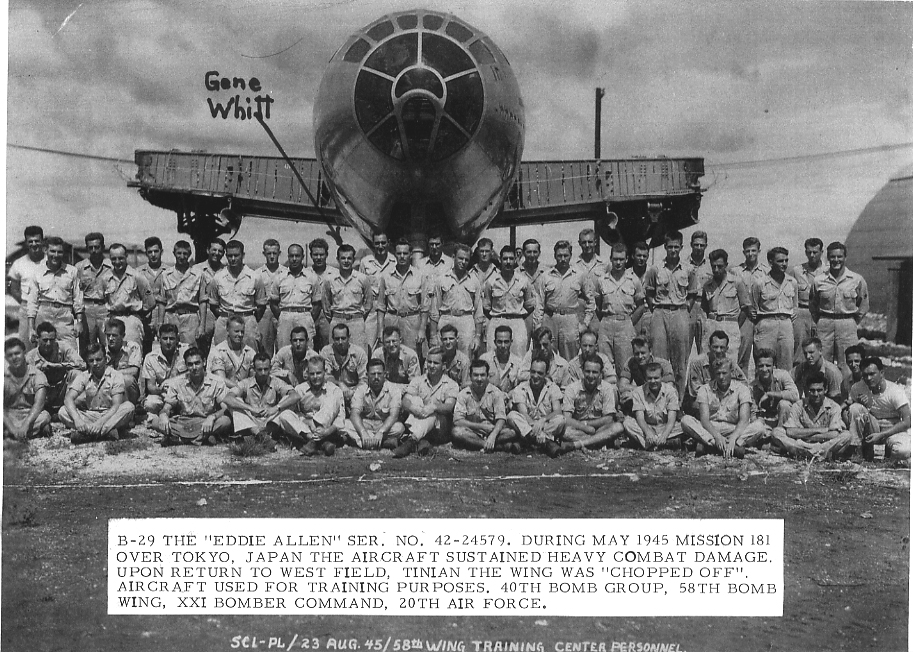 At
the end of the war all specialists at the 58th Bomb Wing Training Center on
Tinian posed
for this picture. Over half of them were operators of the eight Link Trainers in the Quonset out of sight to the left. At the
very far right is just a small corner of the shed roof covering the Diesel
powered electric system to run the eight Links, Lights, twelve LORANs and three
Supersonic trainers. I have yet to meet any of these men post war.
At
the end of the war all specialists at the 58th Bomb Wing Training Center on
Tinian posed
for this picture. Over half of them were operators of the eight Link Trainers in the Quonset out of sight to the left. At the
very far right is just a small corner of the shed roof covering the Diesel
powered electric system to run the eight Links, Lights, twelve LORANs and three
Supersonic trainers. I have yet to meet any of these men post war.
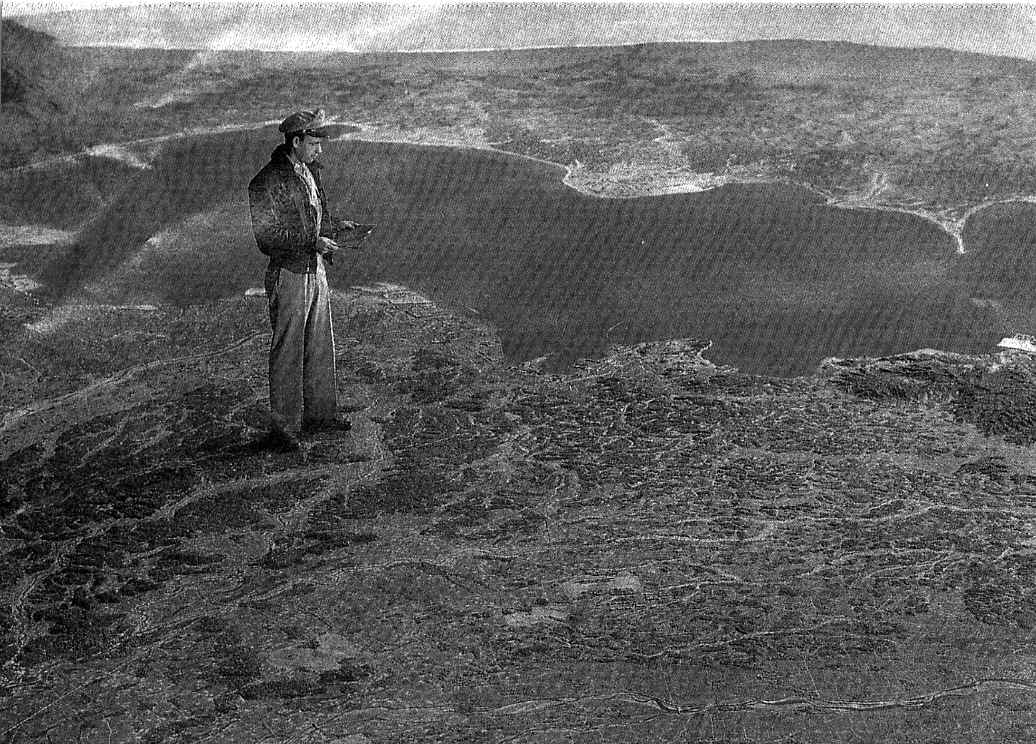 This
photo is taken inside a large hangar type building where a
This
photo is taken inside a large hangar type building where a
large three dimensional relief map of the Nagasaki region of Japan is
represented. I have been unable to relate it to the chart. This was done
somewhere in Kansas. There were overhead cranes that could make practice
simulated visual bombing missions over such pictorials.
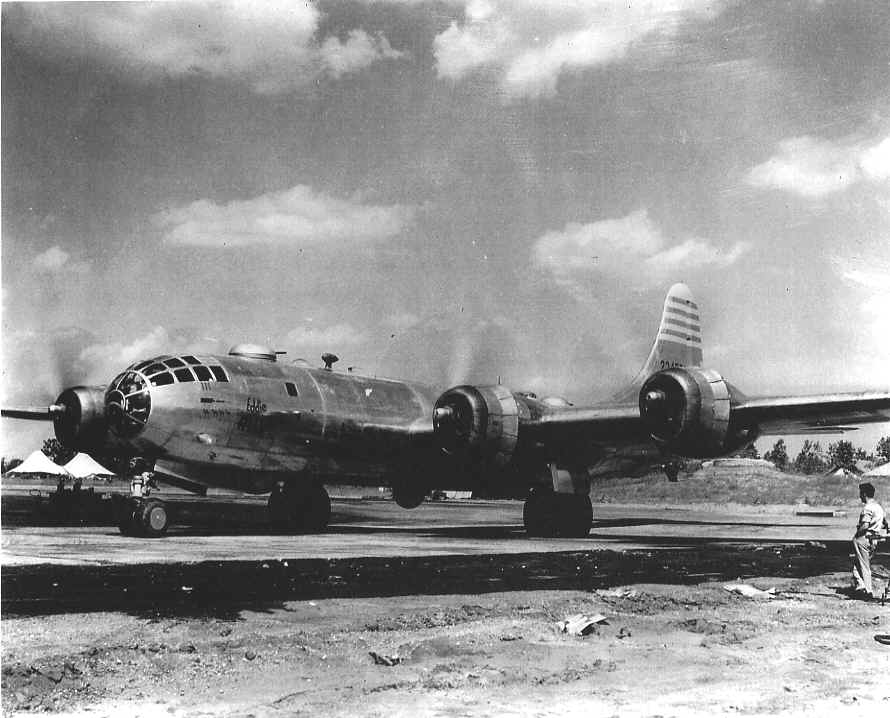 This
is the Eddie Allen in the ramp area of its base near Calcutta, India. The
tents in the background are British with a double layered canvas roof.
Much cooler than the single layer U.S. tents which also leaked in rain if
touched from the inside..
The plane was named after Boeing's chief test pilot who died while trying to
determine the reasons for so many engine fires on B-29s. He was testing
the third production B-29 and crashed in an industrial area of Seattle.
Note that there are only three bombs under the window and four camels for hump
flights..
This
is the Eddie Allen in the ramp area of its base near Calcutta, India. The
tents in the background are British with a double layered canvas roof.
Much cooler than the single layer U.S. tents which also leaked in rain if
touched from the inside..
The plane was named after Boeing's chief test pilot who died while trying to
determine the reasons for so many engine fires on B-29s. He was testing
the third production B-29 and crashed in an industrial area of Seattle.
Note that there are only three bombs under the window and four camels for hump
flights..
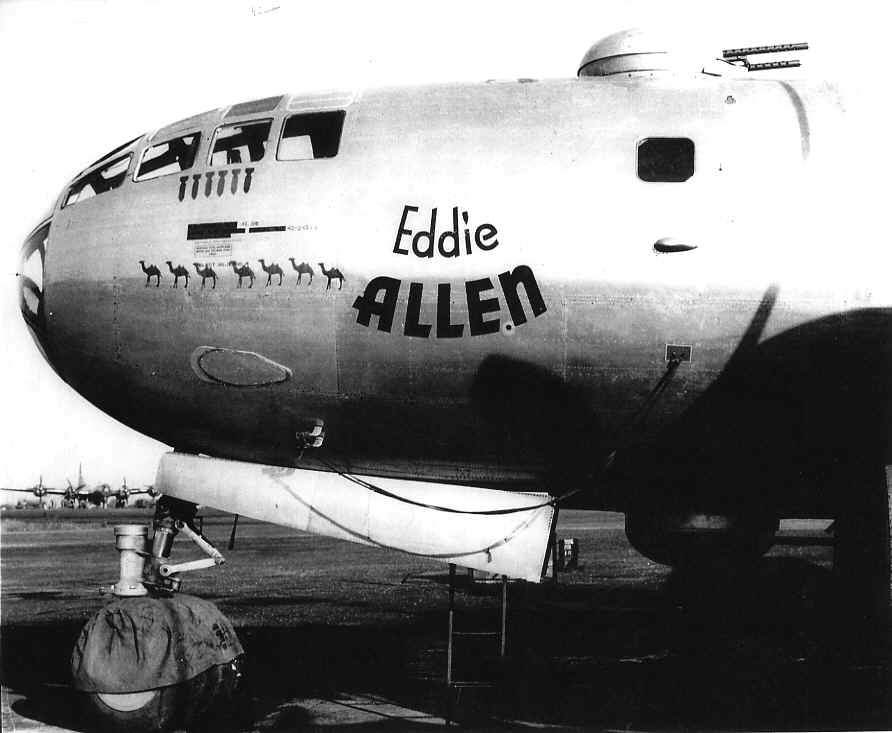 The
nose wheel is covered to protect the rubber from sun damage. The fact that
there were only two machine guns in the front top turret shows the plane to be
an older model. The seven camels are for round trips from India to China. The six bombs are for bombing missions. I would guess that the pictures
are close to two months apart.
The
nose wheel is covered to protect the rubber from sun damage. The fact that
there were only two machine guns in the front top turret shows the plane to be
an older model. The seven camels are for round trips from India to China. The six bombs are for bombing missions. I would guess that the pictures
are close to two months apart.
War in the China, Burma, India (CBI) was
not very efficient. Before a bombing raid could be launched from China against
Japan three round trips over the 'Hump' had to be flown to get the required bomb
and fuel supplies for the raid. Far more planes and crew were lost on the
support flights than in combat.
 The
Offset Aiming Point (AP) that allowed certain pathfinder B-29s equipped with
APQ-23 radar equipment to put in the distance and azimuth from a radar visible
point and a target point into the radar computer. This was the
great-granddaddy of RNAV that allows VORs and airways to be electronically
offset to provide better traffic separation between aircraft.
MPI means mean point of impact. (Average distance from intended impact point.)
The
Offset Aiming Point (AP) that allowed certain pathfinder B-29s equipped with
APQ-23 radar equipment to put in the distance and azimuth from a radar visible
point and a target point into the radar computer. This was the
great-granddaddy of RNAV that allows VORs and airways to be electronically
offset to provide better traffic separation between aircraft.
MPI means mean point of impact. (Average distance from intended impact point.)









